Microlearning Market Size
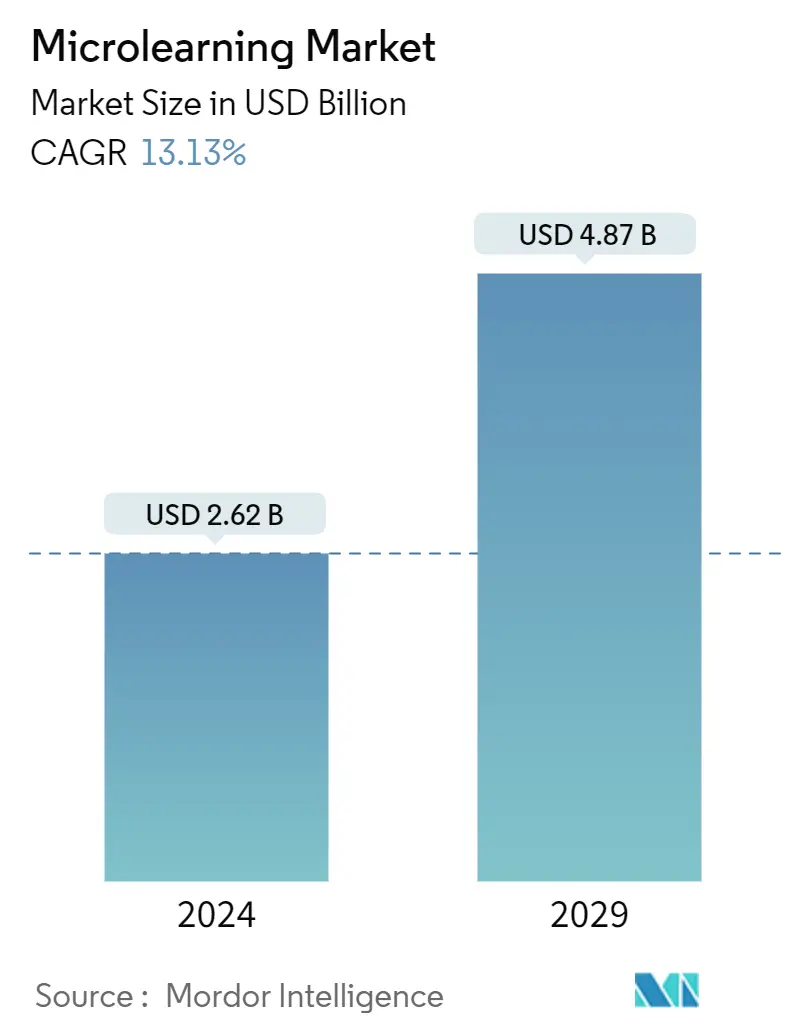
| Study Period | 2019 - 2029 |
| Market Size (2024) | USD 2.62 Billion |
| Market Size (2029) | USD 4.87 Billion |
| CAGR (2024 - 2029) | 13.13 % |
| Fastest Growing Market | Asia Pacific |
| Largest Market | North America |
Major Players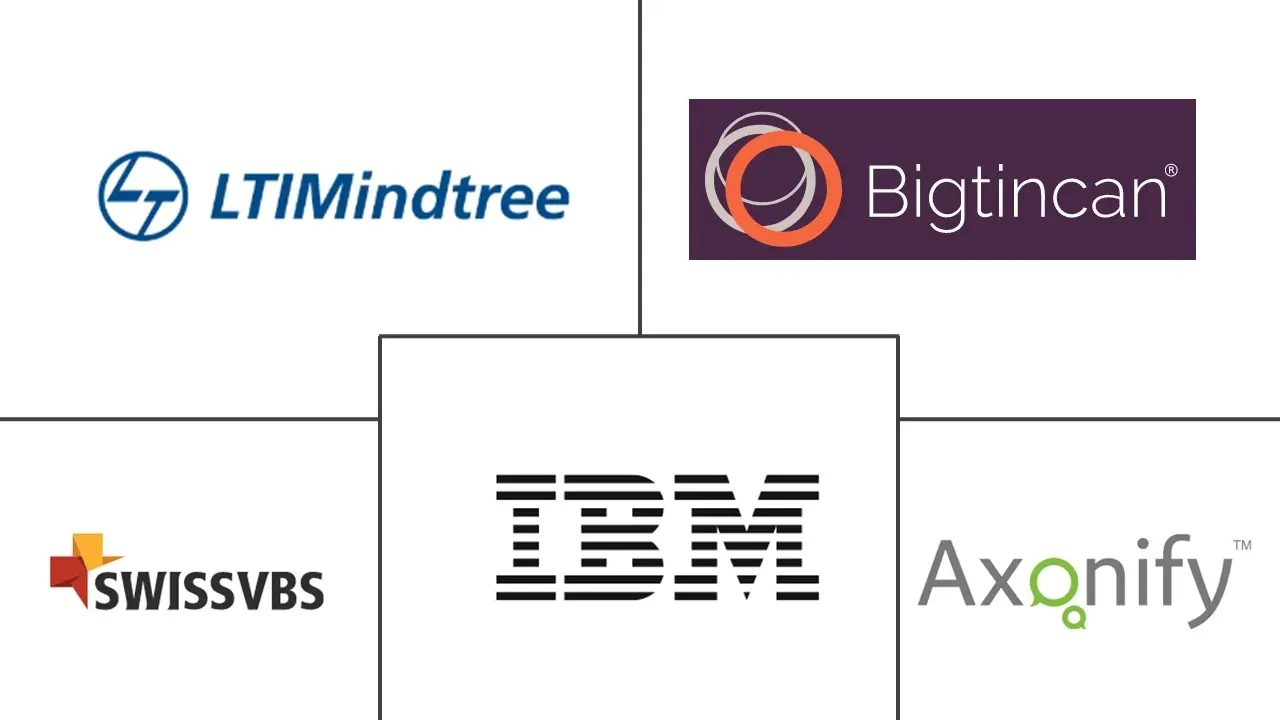
*Disclaimer: Major Players sorted in no particular order |
Microlearning Market Analysis
The Microlearning Market size is estimated at USD 2.62 billion in 2024, and is expected to reach USD 4.87 billion by 2029, growing at a CAGR of 13.13% during the forecast period (2024-2029).
- The use of microlearning is rapidly becoming more common across workplaces, homes, and educational institutions. According to the NTL Institute of Applied Behavioral Science Learning Pyramid model, the traditional learning methods based on listening, reading, and observing are ineffective. The person might recall only 20% to 30% of the contents. The advancement in technology based on simulation learning is effectively driving the market's growth, with a high percentage of learning outcomes.
- The need to train mobile workers in numerous global organizations is a crucial element driving the growth of the global microlearning market. Another major market-driving factor is the expansion of the growing need for skill-based and result-oriented training that may give measurable results for businesses.
- Microlearning is a holistic approach toward e-learning that majorly deals with using small learning units to deliver training. Microlearning involves designing bite-sized learning nuggets to help learners acquire and retain knowledge better, each meeting a specific learning outcome. It is a promising learning approach in e-learning because of its several benefits to learners and instructors.
- Also, the increased adoption and availability of cloud-based solutions have been significant drivers for the market. They provide the platform and necessary infrastructure to address the scalability limitation of the traditional on-premise microlearning experiences. Moreover, microlearning has been witnessing an increased implementation in existing applications and platforms, which includes gamification for customer engagement and value creation.
- Furthermore, the growing demand from millennials for higher flexibility and variation of jobs has significantly resulted in a considerable workforce consisting of freelancers changing their positions frequently and working on different projects at different organizations instead of doing routine long-hour jobs. Therefore, these freelancers have become a potential target audience for microlearning solution providers.
- Furthermore, the gamification of training and education to enhance microlearning acceptability will create further opportunities for the microlearning industry to develop. However, a lack of motivation among learners could further challenge the expansion of the microlearning market.
- During the pandemic, several industry verticals used micro-learning approaches to teach their staff about using the latest technology and procedures to run company activities, leading to considerable micro-learning market growth. The micro-learning program helped people acquire new skills by utilizing videos, audio, and the personal experiences of diverse industry experts. COVID-19 provided immense opportunities for microlearning in various end-user industries, and thus, the market will grow in the long run.
Microlearning Market Trends
Cloud segment is expected to grow at a higher pace
- Companies have realized that skills-based processes effectively solve the increased difficulties since the epidemic. Employers need help to recruit qualified applicants for critical open positions and keep the talent they have hired. Companies that use a skills-based approach can increase the quantity and quality of people who apply for available jobs and help employees discover more possibilities to progress internally, which can help employers improve retention.
- Furthermore, the growing demand from millennials for higher flexibility and variation of jobs has significantly resulted in a considerable workforce consisting of freelancers changing their positions frequently and working on different projects at different organizations instead of doing routine long-hour jobs. Therefore, these freelancers have become a potential target audience for microlearning solution providers.
- Skills-based methods assist companies in locating and attracting a larger pool of talent comprised of individuals who are more equipped to fill these roles in the long run. Such approaches also open doors for atypical applicants, such as those who lack particular or usual qualifications on their resumes.
- In September 2022, Coursera, Inc. announced the expansion of Clips, which provides employees access to nearly 2,00,000 short videos and lessons designed to help them begin learning high-demand skills in less than 10 minutes.
- According to a survey conducted by Training Magazine in the United States, most online trainings were offered for compulsory or compliance training this year. More than half of the training businesses supplied mandatory or compliance training. Less than ten percent of organizations in this category supplied only online executive development training, whereas 17 percent of the same companies said they would offer such training in person this year.
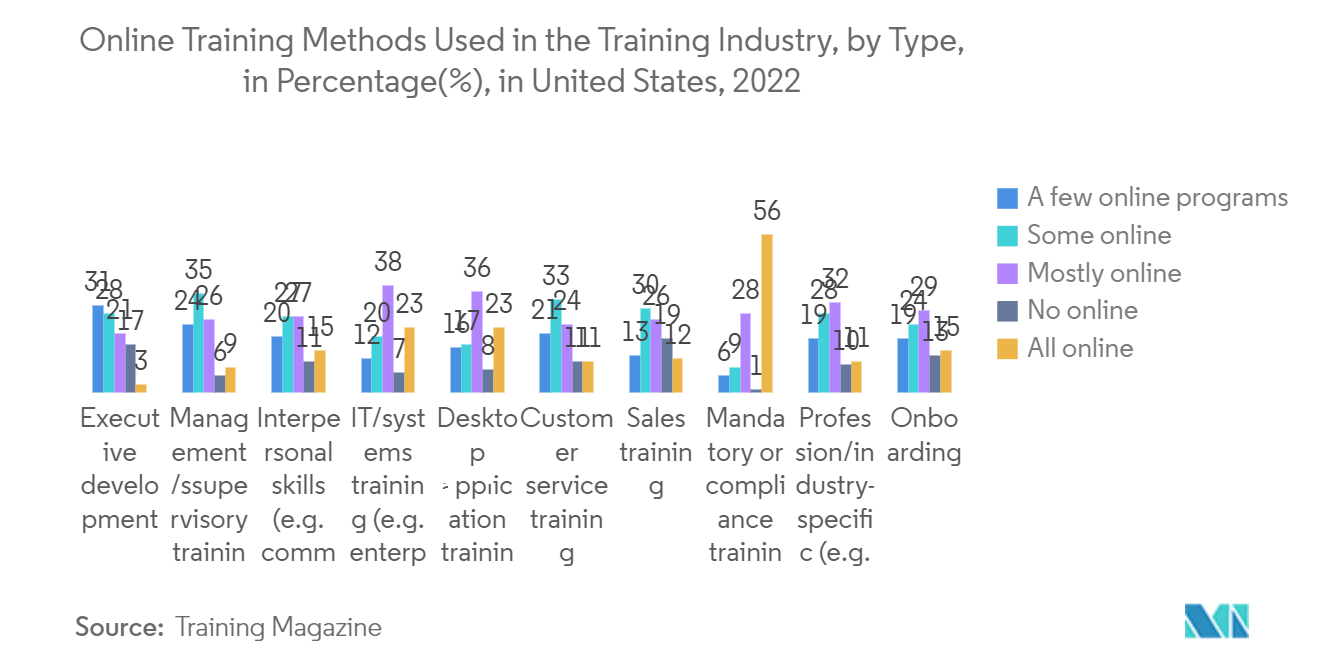
North America is Expected to Hold Major Share
- The North American eLearning market accounts for a significant share of the industry. It is increasing due to the fast technological adoption by numerous organizations to provide adequate training to their employees. The growth of e-learning will provide immense opportunities to microlearning providers in the region.
- Another influencing factor is the increased penetration of digital devices. According to GSMA, the number of smartphone subscribers in North America is expected to reach 328 million by 2025. Moreover, by 2025, the region may witness an increase in the penetration rates of mobile subscribers (86%) and the internet (80%), the second-highest in the world. Increased device penetration will positively impact the virtual reality market in the region.
- Organizations that are focusing on modern learning, supported by the government, are leading to market expansion. Canadians for 21st Century Learning and Innovation (C21 Canada) is a national, non-profit organization that aims to 21st-century models of learning in education. It handles initiatives dedicated to creating a 21st-century learning vision and framework that inspires Canadians.
- Gamification in microlearning solutions is also a handy tool for increasing the overall productivity of employees by using various methods, such as rewards for task completion in case of project management or data contribution or access in case of knowledge management. However, the industry is also facing an absence of standardized guidelines for applying gamification due to the need for substantial academic research.
- According to a report from IBM, 75% of Gen Z'ers prefer to use a smartphone compared to other mobile devices. So, a mobile-focused training strategy in microlearning will grow in the future to interest them in learning. Changing economic, social, and behavioral aspects such as these leading to acceptance of technology at an exponential rate will only boost the market growth of microlearning in the region, making them sustainable solutions.
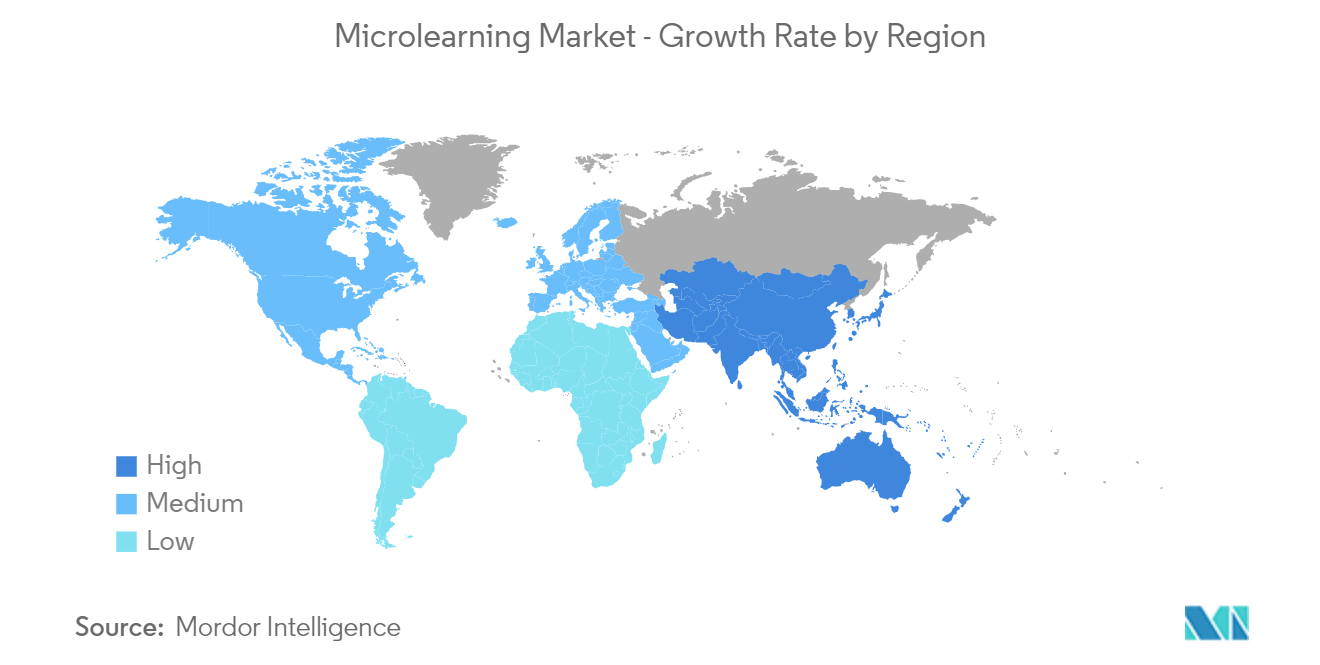
Microlearning Industry Overview
The market is fragmented, with many local and regional players competing in a fast-growing microlearning market. Players in the microlearning market are engaged to offer their content through the interactive medium that will develop a high interest of the learners in these training platforms. Players in the market are adopting strategies such as partnerships and acquisitions to enhance their service offerings and gain sustainable competitive advantage. Some market players are Mindtree Limited, IBM Corporation, SwissVBS, Axonify, and Bigtincan.
September 2023: Axonify, a player in frontline employee enablement and Zebra Registered ISV partner, has developed its work with Zebra Technologies. Further, being among the first co-sale associates for Zebra's software solutions, Axonify also provides {Zebra with a new learning platform. Together, Axonify and Zebra will work to obtain available training for frontline workers directly on the Zebra mobile devices they use every day. Zebra will blend its real-time task management capabilities with Axonify's personalized learning and training modules as part of the enhanced partnership.
Microlearning Market Leaders
-
Mindtree Limited
-
IBM Corporation
-
SwissVBS
-
Axonify Inc.
-
Bigtincan
*Disclaimer: Major Players sorted in no particular order
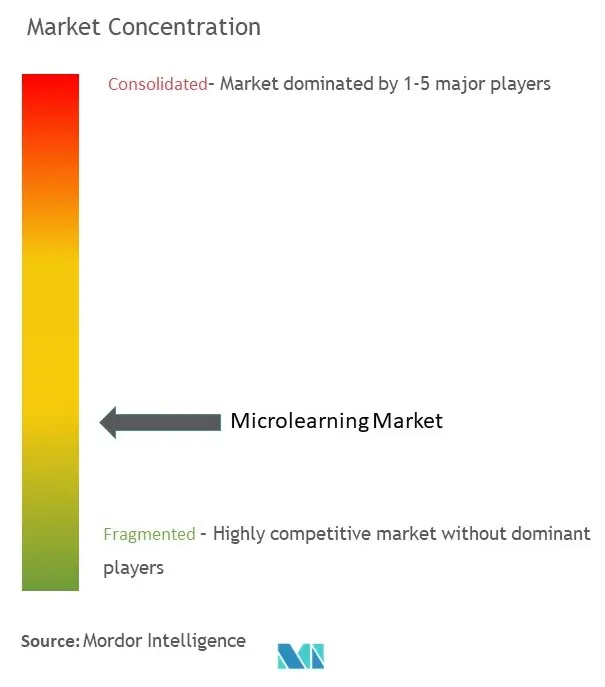
Microlearning Market News
- August 2023: Valamis, a leading global player in digital learning technologies and workforce development, announced a new strategic partnership with iAM Learning, a renowned destination for high-quality eLearning that captivates and engages learners. iAM specializes in creating unique, fun, bite-size learning experiences; iAM Learning uses beautiful, advanced animation, captivating storytelling, and vibrant characters to make learning fun. As a result, learners are more engaged and far more likely to include information and convert that into practical change.
- March 2023: Centrical, the performance experience platform for frontline employees, announced AI Microlearning, their integration of OpenAI's generative AI, ChatGPT. AI Microlearning allows range creators to auto-generate high-impact microlearning content, including scope summaries, related questions and answers, and knowledge check quizzes at a fast speed. AI Microlearning accelerates time to value by allowing contact centers, BPOs, and other CX associations to scale content creation and keep it fresh with less effort and resources. Leveraging the further capabilities, consumers can generate content now to drive organizational agility, keeping frontline workers proficient on new products, suggestions, processes, and compliance rules.
Microlearning Market Report - Table of Contents
1. INTRODUCTION
- 1.1 Study Assumptions and Market Definition
- 1.2 Scope of the Study
2. RESEARCH METHODOLOGY
3. EXECUTIVE SUMMARY
4. MARKET INSIGHTS
- 4.1 Market Overview
- 4.2 Industry Value Chain Analysis
-
4.3 Industry Attractiveness - Porter's Five Forces Analysis
- 4.3.1 Bargaining Power of Suppliers
- 4.3.2 Bargaining Power of Consumers
- 4.3.3 Threat of New Entrants
- 4.3.4 Threat of Substitutes
- 4.3.5 Intensity of Competitive Rivalry
- 4.4 Assessment of Impact of COVID-19 on the Industry
5. MARKET DYNAMICS
-
5.1 Market Drivers
- 5.1.1 Increasing Demand for Training Deskless and Mobile Workers
- 5.1.2 Growing Need for Skills-Based and Result-Oriented Training
- 5.1.3 Gamification of Training and Education
-
5.2 Market Restraints
- 5.2.1 Reluctance of enterprises to spend huge amount on transforming existing training content into microcontent
6. MARKET SEGMENTATION
-
6.1 By Component
- 6.1.1 Solution
- 6.1.2 Services
-
6.2 By Organization Size
- 6.2.1 Large Enterprises
- 6.2.2 Small and Medium-Sized Enterprises
-
6.3 By Deployment Mode
- 6.3.1 On-Premise
- 6.3.2 Cloud
-
6.4 By End User
- 6.4.1 Retail
- 6.4.2 Manufacturing
- 6.4.3 Banking, Financial Services and Insurance
- 6.4.4 Telecom and IT
- 6.4.5 Other End Users (Healthcare and Life Sciences, Logistics)
-
6.5 By Geography
- 6.5.1 North America
- 6.5.2 Europe
- 6.5.3 Asia-Pacific
- 6.5.4 Rest of the World
7. COMPETITIVE LANDSCAPE
-
7.1 Company Profiles*
- 7.1.1 Mindtree Limited
- 7.1.2 IBM Corporation
- 7.1.3 SwissVBS
- 7.1.4 Axonify Inc
- 7.1.5 Bigtincan
- 7.1.6 Saba Software
- 7.1.7 iSpring Solutions Inc.
- 7.1.8 Epignosis
- 7.1.9 Qstream, Inc.
- 7.1.10 Cornerstone OnDemand, Inc.
8. INVESTMENT ANALYSIS
9. MARKET OPPORTUNITIES AND FUTURE TRENDS
** Subject To AvailablityMicrolearning Industry Segmentation
Microlearning is the process of breaking down employee training into small, bite-sized pieces. The goal is to use short courses that are easy for employees to learn and apply quickly. It offers benefits such as mobile access, limited distraction, just-in-time learning, and actionable content.
The Microlearning Market is segmented by Component (Solution, Services), Organization Size (Large Enterprises, Small and Medium-Sized Enterprises), Deployment Mode (On-Premise, Cloud), End-User (Retail, Manufacturing, Banking, Financial Services, and Insurance, Telecom, and IT) and by Geography.
The market sizes and forecasts are provided in terms of value (in USD) for all the above segments.
| By Component | Solution |
| Services | |
| By Organization Size | Large Enterprises |
| Small and Medium-Sized Enterprises | |
| By Deployment Mode | On-Premise |
| Cloud | |
| By End User | Retail |
| Manufacturing | |
| Banking, Financial Services and Insurance | |
| Telecom and IT | |
| Other End Users (Healthcare and Life Sciences, Logistics) | |
| By Geography | North America |
| Europe | |
| Asia-Pacific | |
| Rest of the World |
Microlearning Market Research FAQs
How big is the Microlearning Market?
The Microlearning Market size is expected to reach USD 2.62 billion in 2024 and grow at a CAGR of 13.13% to reach USD 4.87 billion by 2029.
What is the current Microlearning Market size?
In 2024, the Microlearning Market size is expected to reach USD 2.62 billion.
Who are the key players in Microlearning Market?
Mindtree Limited, IBM Corporation, SwissVBS, Axonify Inc. and Bigtincan are the major companies operating in the Microlearning Market.
Which is the fastest growing region in Microlearning Market?
Asia Pacific is estimated to grow at the highest CAGR over the forecast period (2024-2029).
Which region has the biggest share in Microlearning Market?
In 2024, the North America accounts for the largest market share in Microlearning Market.
What years does this Microlearning Market cover, and what was the market size in 2023?
In 2023, the Microlearning Market size was estimated at USD 2.28 billion. The report covers the Microlearning Market historical market size for years: 2019, 2020, 2021, 2022 and 2023. The report also forecasts the Microlearning Market size for years: 2024, 2025, 2026, 2027, 2028 and 2029.
Micro-learning Industry Report
Statistics for the 2024 Microlearning market share, size and revenue growth rate, created by Mordor Intelligence™ Industry Reports. Microlearning analysis includes a market forecast outlook to for 2024 to 2029 and historical overview. Get a sample of this industry analysis as a free report PDF download.



